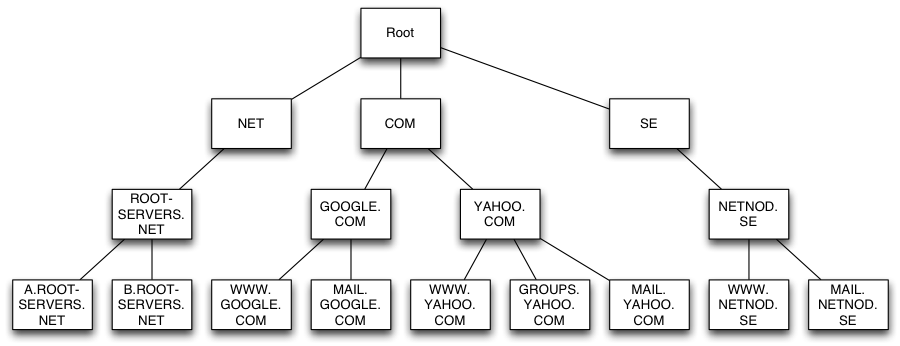A root name server is a name server for the root zone of the Domain Name System of the Internet. It directly answers requests for records in the root zone and answers other requests by returning a list of the authoritative name servers for the appropriate top-level domain (TLD). The root name servers are a critical part of the Internet infrastructure because they are the first step in translating (resolving) human readable host names into IP addresses that are used in communication between Internet hosts.
A combination of limits in the DNS and certain protocols, namely the practical size of unfragmented User Datagram Protocol (UDP) packets, resulted in a decision to limit the number of root servers to thirteen server addresses. The use of anycast addressing permits the actual number of root server instances to be much larger, and is 504 as of 10 October 2014.
Root domain
The Domain Name System is a hierarchical naming system for computers, services, or any resource participating in the Internet. The top of that hierarchy is the root domain. The root domain does not have a formal name and its label in the DNS hierarchy is an empty string. All fully qualified domain names (FQDNs) on the Internet can be regarded as ending with this empty string for the root domain, and therefore ending in a full stop character (the label delimiter), e.g., www.example.com.. This is generally implied rather than explicit, as modern DNS software does not actually require that the terminating dot be included when attempting to translate a domain name to an IP address.
The root domain contains all top-level domains of the Internet. As of July 2015, it contains 1058 TLDs, including 730 generic top-level domains (gTLDs) and 301 country code top-level domains (ccTLDs) in the root domain. In addition, the ARPA domain is used for technical name spaces in the management of Internet addressing and other resources. A TEST domain is used for testing internationalized domain names.
Resolver operation
When a computer on the Internet needs to resolve a domain name, it uses resolver software to perform the lookup. A resolver breaks the name up into its labels from right to left. The first component (TLD) is queried using a root server to obtain the responsible authoritative server. Queries for each label return more specific name servers until a name server returns the answer of the original query.
In practice, most of this information does not change very often over a period of hours and therefore it is cached by intermediate name servers or by a name cache built into the user's application. DNS lookups to the root name servers may therefore be relatively infrequent. A survey in 2003 reports that only 2% of all queries to the root servers were legitimate. Incorrect or non-existent caching was responsible for 75% of the queries, 12.5% were for unknown TLDs, 7% were for lookups using IP addresses as if they were domain names, etc. Some misconfigured desktop computers even tried to update the root server records for the TLDs. A similar list of observed problems and recommended fixes has been published in RFC 4697.
Although any local implementation of DNS can implement its own private root name servers, the term "root name server" is generally used to describe the thirteen well-known root name servers that implement the root name space domain for the Internet's official global implementation of the Domain Name System.
Root server addresses
As of July 2015, there are 13 root name servers specified, with names in the form letter.root-servers.net, where letter ranges from A to M. This does not mean there are 13 physical servers; each operator uses redundant computer equipment to provide reliable service even if failure of hardware or software occurs. Additionally, nine of the servers operate in multiple geographical locations using a routing technique called anycast addressing, providing increased performance and even more fault tolerance.
Ten servers were originally in the United States; some are now operated using anycast addressing. Three servers were originally located in Stockholm (I), Amsterdam (K), and Tokyo (M).

